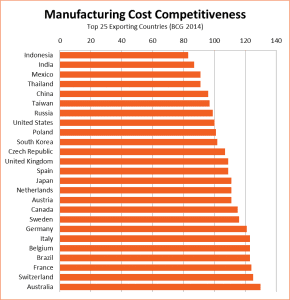Australian manufacturing cost is higher than any other of the top 25 exporters in the world, according to a new report from Boston Consulting Group. It is now 30% more expensive to manufacture here than in the USA. Asian countries like China, India and Indonesia have even bigger cost advantages.
What is driving Australian manufacturing cost?
The report assesses four main cost drivers. Australian manufacturing cost increased in every single one of them over the last decade.
- Labour: Australian wages have increased by 48%. Manufacturing workers are more expensive in Australia than in Germany.
- Energy: (both electricity and natural gas) power now costs 80% more than in 2004.
- Productivity: (value added per worker) This has fallen by 1% in Australia.
- Exchange rate: The Australian dollar has appreciated by 21%, making goods more expensive on global markets.
Dramatic shifts in global manufacturing cost competitiveness
 The report authors say changes in the last ten years are so dramatic that ‘many old perceptions of low-cost and high-cost nations no longer hold’.
The report authors say changes in the last ten years are so dramatic that ‘many old perceptions of low-cost and high-cost nations no longer hold’.
We can no longer think of ‘North America and western Europe as high-cost and Latin America, Eastern Europe and most of Asia-especially China, as low cost. In reality, there are high- and low-cost countries in nearly every region of the world.‘
They advise companies to ‘rethink their sourcing strategies, as well as where to build future capacity. Many will opt to manufacture in competitive countries closer to where goods are consumed.’
However, they also flag that cost-competitiveness is not the only factor in choosing manufacturing sites. Secondary factors include logistics costs; ease of doing business, and perceived levels of corruption.
For example, Indonesia and India rank as low cost, but both countries are considered difficult to do business in. Perceived corruption in these countries and in Thailand is also relatively high.
Impacts for Australian companies and their sourcing policies
While Australian manufacturing cost is certainly high, product made and sold here should have low logistics costs.
If you serve a domestic market only, it may be worth reviewing local sourcing versus one of the cost-competitive Asian countries.
If you have any international business, manufacturing offshore and shipping direct to other countries becomes even more attractive.
A word of warning, though – if you do opt for offshore manufacture, you will need to manage a more complex supply chain. There are issues of language, culture, legal systems and logistics. Little ‘snags’ can be much harder to sort out long-distance. Unless you have the scale to invest in your own staff on the ground, you may want to use an experienced sourcing agent to represent you. Hornet have experience sourcing from both China and India – plus our own offices in China. So if you think we can help you, contact us and let’s discuss it further!
Selected highlights from the report are available here.
